Fulbright Brazil Project: Shrimp and Crustacean Research
Thanks to a Fulbright-Brazil Scientific Mobility Program Distinguished Chair Award (2014-15), I was able to travel to Brazil to do collaborative research with my Brazilian colleagues at UNESP (Universidade Estuadal Paulista) campuses in Botucatu [Drs. Antonio ("Tony") Castilho; Maria Lucia Negreiros, Adilson Fransozo], UNESP Bauru (Dr. Rogerio Costa), and UNESP Jaboticabal (Dr. Fernando Zara), and University of São Paulo, Ribeiro Preto (Dr. Fernando Mantelatto), with their large group of enthusiastic graduate students. Our common interests focus on the reproduction, ecology, and evolution of the diverse shrimp populations off the southeast coast of Brazil. The overall project title of the research is "Latitudinal Gradients in Seasonality of Reproduction in Marine Shrimps: Proximate and Ultimate Causes." During the Bauer Fulbright stay in Brazil, various subprojects were discussed and planned, and writing of a collaborative manuscript on shrimp research was finished [will be published in the first issue of volume 35 (2015) of the Journal of Crustacean Biology].
A two-week course ("Tópicos Especias em Zoologia: Ecologia, Sistemática e Ciclo de Vida dos Camarões") was presented to graduate students from various UNESP campuses, with lectures, student presentations and research both at the Botucatu Campus and at a field laboratory set up near the coast.
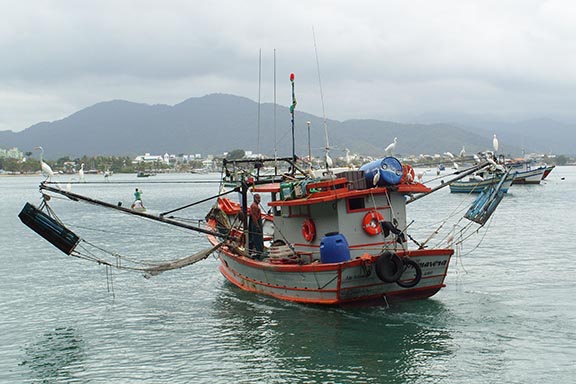 |
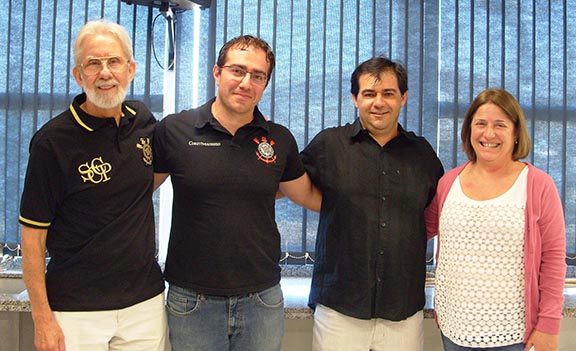 |
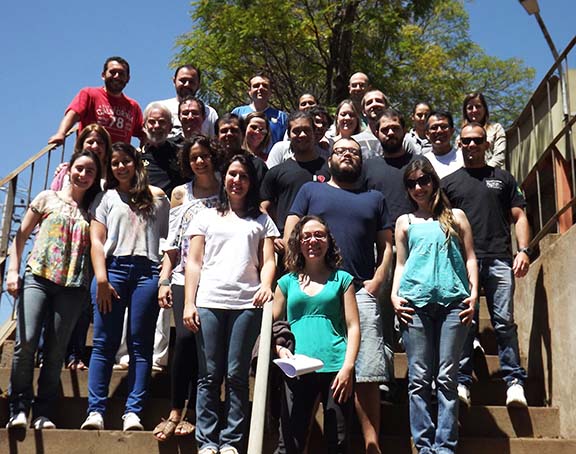 |
| The shrimp trawling vessel "Primavera" anchored in Ubatuba Bay, used to sample shrimp and other crustacean populations | Professors Ray Bauer, Tony Castilho, Rogerio Costa, Maria Lucia Negreiros Fransozo | Students and p rofessors of the shrimp short course pose for a group photo at UNESP Botucatu |
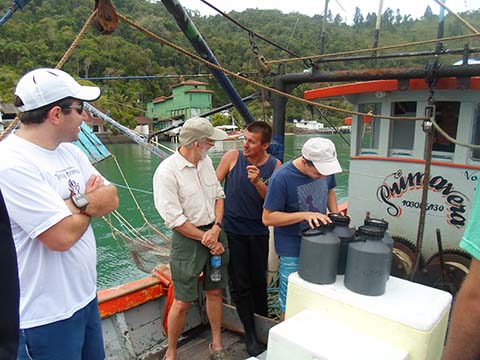 |
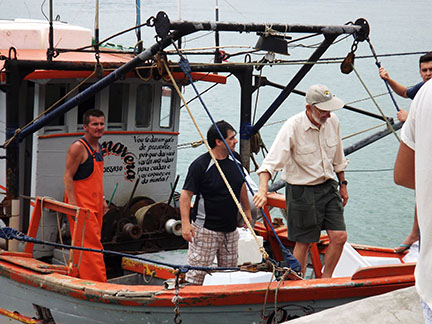 |
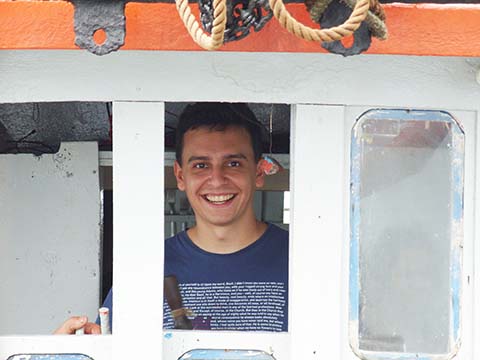 |
| From left, Tony Castilho observes a scientific discussion in Portuguese between Ray Bauer and ship captain
Djalma de Oliveira, nicknamed "Pasarhino" ("Little Bird") as doctoral student João Pantaleão prepares for sampling |
Pasarhino, Rogerio Costa, and Ray Bauer on the Primavera |
João Pantaleão at the wheel on the Primavera |
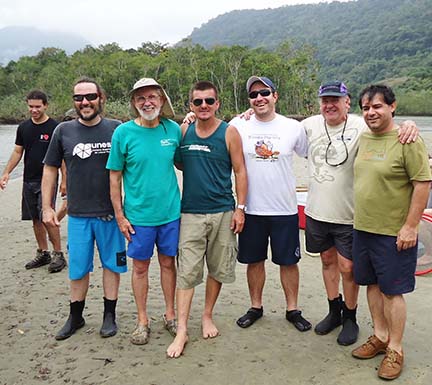 |
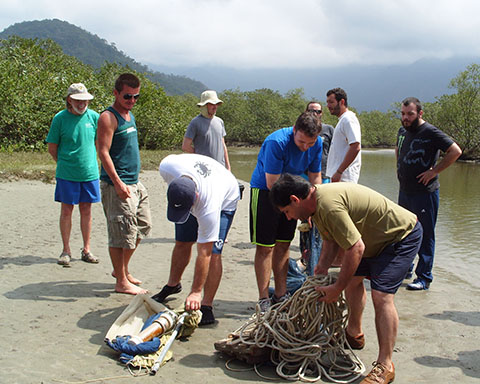 |
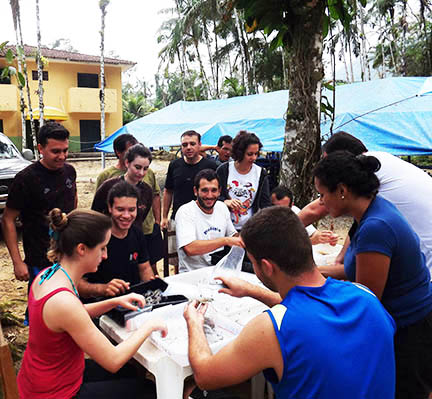 |
| From left, doctoral student Thiago da Silva, Professors Fernando Zara and Ray Bauer, Captain Pasarhino, Professors Tony Castilho and Rogerio Costa at the Praia Dura mangrove with students to sample mangrove crustaceans | Prepartion of sampling gear at the mangrove |
Students at the field laboratory sorting, identifying, measuring, sexing, determining reproductive condition for the database of collaborative research projects |
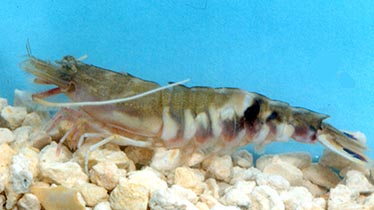 |
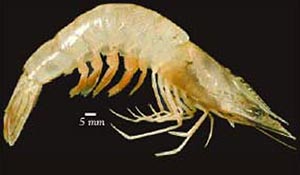 |
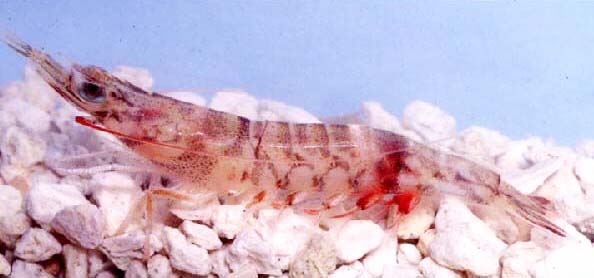 |
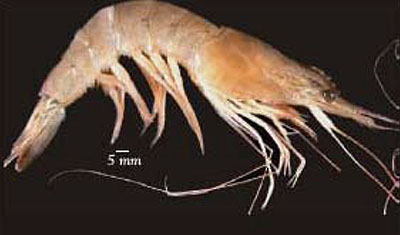 |
|
Sicyonia dorsalis (rock shrimp; camarão rocha) |
Litopenaeus schmitti (white shrimp; camarão branco) |
Rimapenaeus constrictus (roughneck shrimp) |
Xiphopenaeus kroyeri (seabob; camarão setebarbas) |
Some of the species sampled during our field work are shown above (photos of Litopenaeus and Xiphopenaeus are from Costa, R.C. et al. 2003.Chave ilustrada para indentificão does camarões Dendrobranchiata do litoral norte do estado de Saõ Paulo, Brazil. Bioneotropica 3(1)
Graduate Student Presentations of Research
At the field laboratory with blue tarp roof:
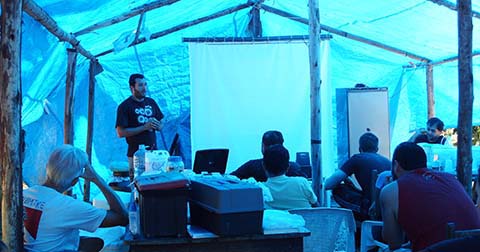 |
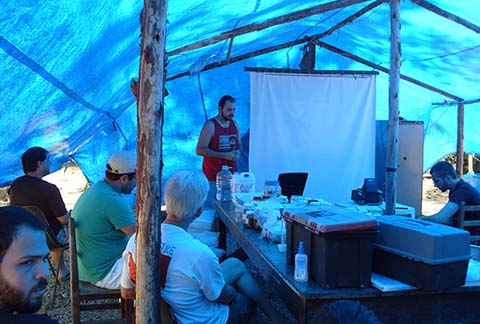 |
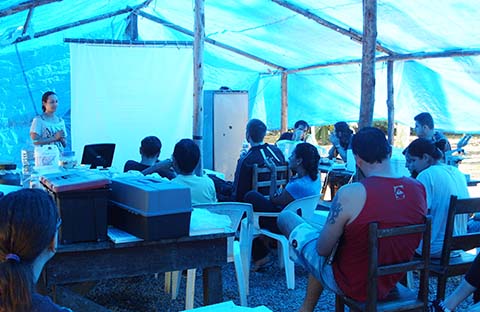 |
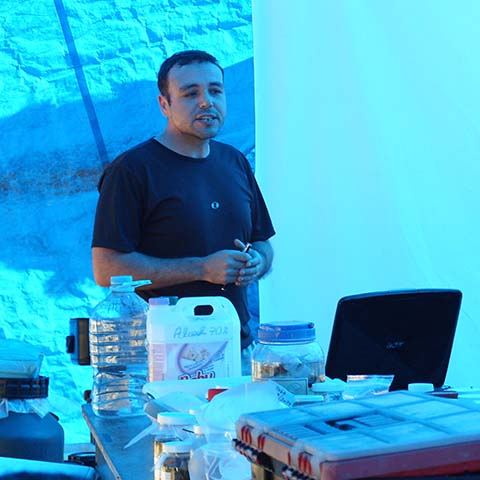 |
|
Abner Batista research presentation on the shrimp Xiphopenaeus kroyeri |
Daniel Lima presentation on hermit crabs |
Geslaine Gonçalves on crustacean associations with jellyfish |
Gilson Stanski on hermit crab work |
At the Zoology Department UNESP Botucatu:
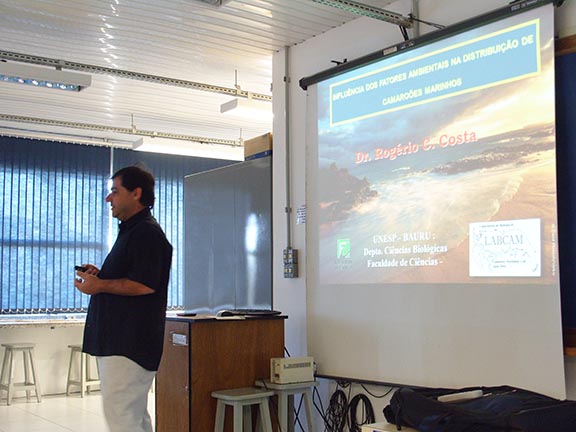 |
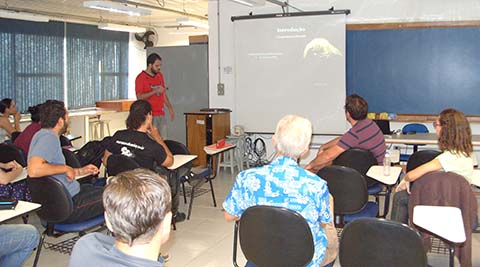 |
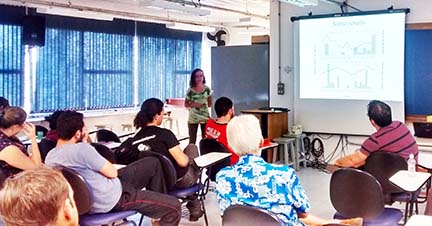 |
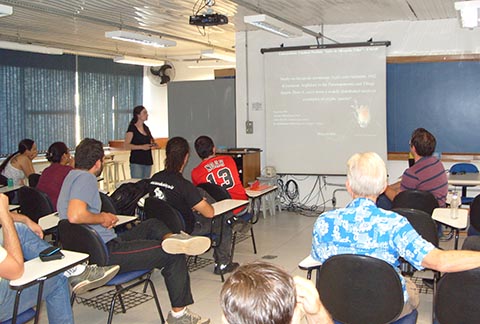 |
|
| Professor Rogerio Costa giving a class lecture on shrimp ecology | João Barioto presentation on the camarão branco (white shrimp) | Joyce Garcia talk on the roughneck shrimp Rimapenaeus constrictus | Milena Wolf presentation on freshwater crabs (Aegla) |
Social and Cultural Activities:
Much of the scientific and cultural Fulbright exchange takes place in more informal settings. Additionally, the expression "all work and no play make Jack a dull boy" applies to educational and scientific activities as well. Brazilian graduate students and professors shared ideas and culture, practiced their English and Ray Bauer his Portuguese, discussed possible future research and educational interchange with Bauer's lab at the University of Louisiana, Lafayette, during coffee breaks, parties, lunches and dinners, visits to local fazendas and markets. Several graduate students discussed educational and professional activities with Dr. Bauer during both these informal activities as well as in more formal discussions in Dr. Bauer's office at the Zoology Department at UNESP Botucatu. Bauer and his wife Lydia extended their invitation for future student and professor visitors to stay in the "Pousada Bauer"
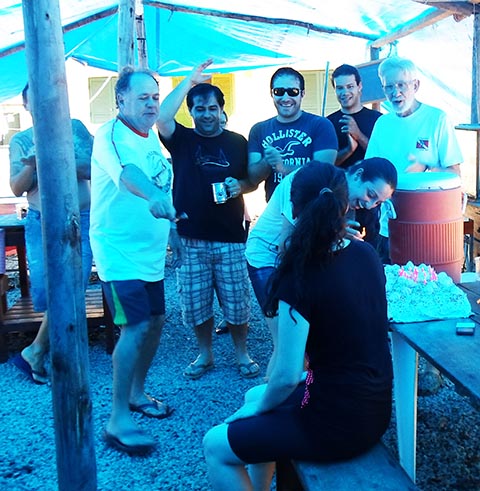 |
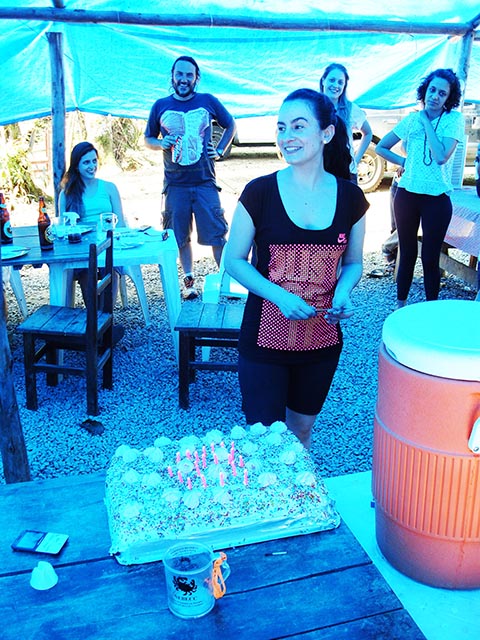 |
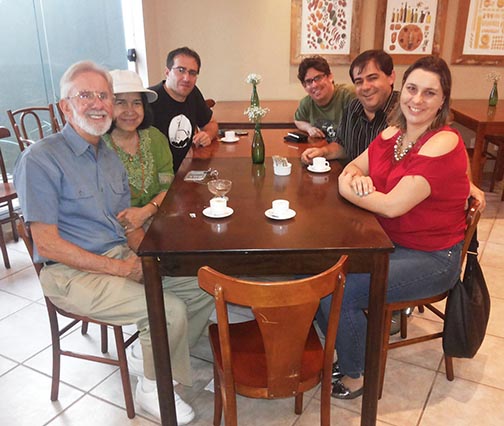 |
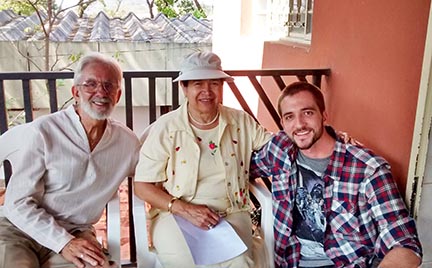 |
|
| At field laboratory, Professors Adilson Fransozo, Rogerio Costa, Tony Castilho, grad student Thiao da Silva, and Ray Bauer celebrate as Geslaine Gonçalves prepares birthday cake for Milena Wolf | Milena Wolf prepares to blow out candles on birthday cake as (standing, left to right) Prof. Fernando Zara and grad students Daphne Herrera and Sara Teodoro look on | Clockwise, Ray and Lydia Bauer, Tony Castilho, doctoral student Gabriel Bochini, and Rogerio and Fernanda Costa prepare to finish a lunch at one of Bauru's well known "restaurantes por kilo." | Ray and Lydia Bauer with good friend, doctoral student Rafael Grabowski, at a daily coffee break with other students and professors in the balcony of Professor Maria Lucia Negreiros |
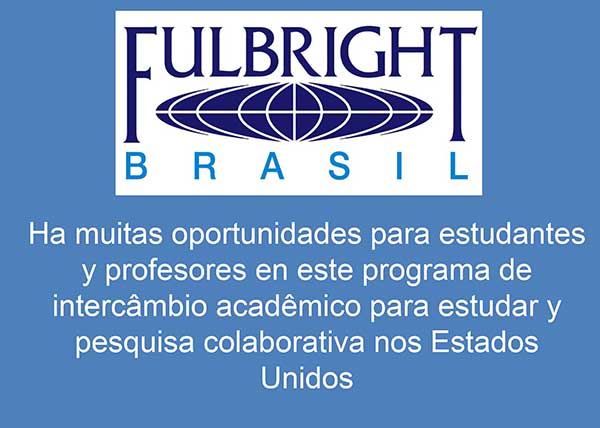 |
| Many thanks to the Fulbright Foundation and the Brazil Fulbright Commission for making possible our productive interchange between Brazil and the USA. Students and professors from Brazil and the USA are encouraged to take advantage of the many programs that Fulbright provides to encourage scientific and academic collaboration between our two great countries. The Fulbright staff in the USA and in Brazil were most helpful and supportive both during the application process and during the grant. Special thanks are extended to Dr. Luiz Valcov Loureiro, Executive Director, and Bruno Betat, Program Specialist, Fulbright Comission in Brazil, for their much appreciated aid and support. |